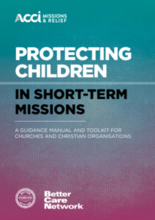The Child Protection in Short-Term Missions Manual and Toolkit has been produced by ACC International Missions and Relief. It has been designed for those who are passionate about missions and engaging people in missions through short-term teams, who pursue excellence in all they do and who are committed to pursuing God’s heart for children and vulnerable members of society in the context of global missions.
The principles explored in the manual are drawn from the Bible, best practice concepts, as well as development, missiology, and cross cultural theories. Whilst they have been specifically applied here to engaging with children during short-term mission (STM) trips, many of them can be broadly applied. Therefore, as you work through the principles, you may discover other really relevant applications, which will also enhance the non-child centred aspects of your STM program.
The manual and toolkit have been designed to be used by those who are responsible for overseeing and/or coordinating a STM program that either sends or receives STM teams. This could include missions pastors, team coordinators, service learning coordinators, missionaries, donor engagement and church partnerships coordinators, or staff from local churches, charities, volunteer agencies and grass roots organisations. Whilst there are resources contained within the toolkit to help you train and equip teams, the manual is not designed for team members themselves to read.
The manual focuses on protecting children and upholding their best interests in STM programs. However, its relevance is not limited to STM programs that solely work with children, as most teams will come into some sort of contact with children during their trip. Therefore, it is a good idea for all STM programs to include child protection and safeguarding consideration in their program’s design and implementation phases.
This manual is primarily developed to reflect the most common scenario, which involves a sending and a receiving organisation working in partnership. We recognise however that there are a number of alternate models in existence. No matter what model you are using, the same child-safe principles apply. However, you may need to adapt some of the processes in the manual and checklists in the toolkit to fit your particular circumstances.
Inside this document you will find a manual and accompanying toolkit. Together they form a comprehensive guide for developing and implementing an effective and child-safe STM program.

